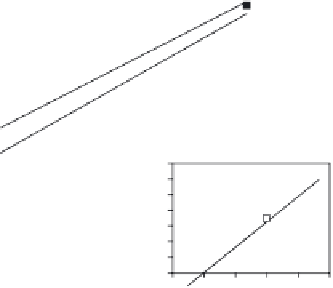Environmental Engineering Reference
In-Depth Information
hardening rate and static recovery of the material. Biaxial tests in Zircaloy-4
show that the presence of hydrides in the cladding will help to prevent the
cold work microstructure from being annealed out of dislocations and thereby
lower creep rates are maintained in the spent fuel cladding.
131
The same alloy
in annealed condition shows a decrease in creep rate when hydrogen is in solu-
tion and an increase when part of the hydrogen is precipitated as hydrides. This
behavior is attributed to the reduction in the stacking fault energy of Zr caused
by diffusion of hydrogen to the core of the screw dislocations and an increase
in their mobility. On the other hand when hydrogen is present in the form of
hydrides, it increases the matrix strength and reduces the creep rate. The creep
rate of Zircaloy-4 at a temperature of 693K and a stress of 150 MPa, a mar-
ginal increase in creep rate is noted for a hydrogen content of 200 wt.ppm. The
increase in the creep rate is believed to be brought out by the reduction in the
modulus value when hydrogen is added.
132
In a Zr-2.5wt.%Nb alloy, the creep
rate at 723K is reported to increase by 2-2.5 times for a hydrogen content of
160 wt.ppm and the stress exponent reduces from 2.41 to 1.59, indicating the
change in creep mechanism (Fig. 3.30).
133
The results above indicate that hydrogen in dissolved state increases the
creep rate and this is pertinent to SF which remains in this temperature
range (~573K) and has suffi cient hydrogen dissolved in it.
10
-5
Longitudinal 5 wt ppm H
Transverse 5 wt ppm H
Transverse 65 wt ppm H
Longitudinal 65 wt ppm H
Longitudinal 160 wt ppm H
10
-6
Transverse 160 wt ppm H
10
-7
14.0
12.0
10.0
10
-8
8.0
6.0
4.0
2.0
0.0
-500
0
500
1000
1500 2000
(Stress)
1.5
MPa
10
-9
10
2
Stress, MPa
3.30
Effect of three levels of hydrogen (5, 65 and 160 wt ppm) on the
creep rate vs stress plot of Zr-2.5 wt% Nb pressure tube material along
longitudinal and transverse orientation. The inset is a typical replot of
one such data set to show that the threshold stress is negligible.

















































Search WWH ::

Custom Search